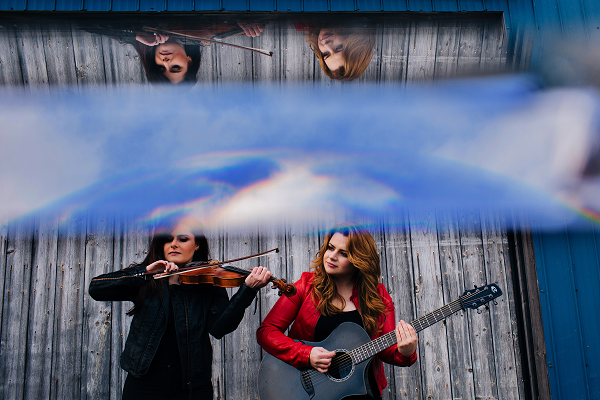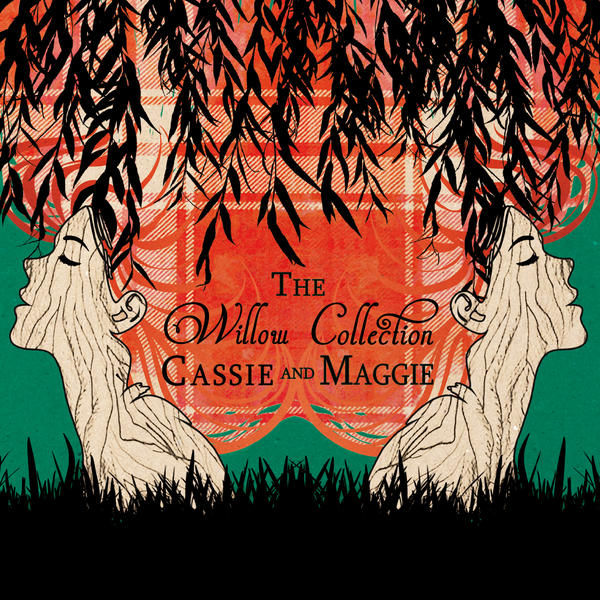Earlier this year, Cassie and Maggie MacDonald released “The Willow Collection,” a stellar and sprightly collection of traditional music delivered in their unique style. In addition to their terrific instrumental work, the new album also features an increased emphasis on vocals – a challenge that they meet in spades. The album leads off with a kicking version of the traditional tune “Hangman” (with which Led Zeppelin fans should be acquainted through “Gallows Pole”), and includes such highlights as “Seileach” and the gorgeous, plaintive “Turn Me Gentle When I’m Dying,” exploring the motif of the willow.
Even with a hectic touring schedule, Cassie MacDonald was kind enough to take some time to answer a few questions about the album.
In the liner notes for the album, you explain the significance of the willow tree as the unifying theme of the record: both the sorrow (unrequited love and bereavement) and the joy (hope and rebirth). What originally drew you to the theme of the willow as a unifying motif for the album?
An excellent question! The willow tree was a natural choice as a unifying theme for the album, it has such a symbolic meaning in folklore, many of the most beautiful and poignant songs in traditional music are inspired by the image of the willow and what it represents. “Down in the Willow Garden,” for example, is arguably one of the more popular and well known willow songs, and was the first song we decided to record for the album. Initially were just going to do a 4 track EP of songs associated with the Willow, but Maggie really did some incredible research and the project quickly evolved into a full length album celebrating the tree’s significance in folk music.
You also mention in the notes that this project gave you the chance to delve into vocal songs in a new way. There are, for example, vocals on your previous release, “Sterling Road” – in what ways did your understanding of, and approach to, vocal songs change during your work on “The Willow Collection”?
We grew up playing mainly instrumental music, fiddle and piano, but more recently we’ve really found a love of traditional folk singing… we wanted to find a way to connect with the immense catalogue of folksongs in the same we connect with instrumental music. This meant delving into many different folk archives containing field recordings of old songs that had been passed down through many generations of traditional singers, not a small task! So we decided to give ourselves a theme that would help focus our research and also help us trace the evolution of certain songs as they traveled across the Atlantic and formed the backbone of many folk genres as we know them today.
In what other ways did this project allow you to push your own musical boundaries?
The new dedication to singing on this project was really a new step for us, we were so lucky to have the opportunity to work with Dave Gunning who recorded and co-produced the album. He really inspired us to push ourselves both in our musicality and arrangements, we were so lucky to have his guidance and mentorship on this project.
I have to ask (as a closet Lawrence Welk fan!) – what inspired you to include a snippet of an intro from the show on your album?
We love Lawrence Welk too! Maggie found the song that he introduces, Blue Willow, in an episode of the show where the Lennon sisters were performing a version of the song. We thought it would be fun to include his intro on the album as a tribute to where we discovered the song.
“Hangman” opens the album with a foot-tapping rhythm, but a (mostly) dark tale. What inspired you to lead off the project with this track specifically?
Great question! The whole album features some really incredible musical guests who we’re so lucky to call friends, but we wanted to start things off with just the two of us, similar to what folks would hear if they came out to one of our live shows… a high energy, lively song with a fun tune to complement the song.

Do you have a particular favorite from this album?
Hmmm, that’s a tough one, all the songs really contribute something unique to the album as a whole… so it’s tricky to choose just one! I think for me, my favourite would be Seileach, I love the contemporary approach we took with the Gaelic song, I think it shows that trad music can really evolve and appeal to such a broad audience but still remain true to its roots.
For those of us outside the Maritimes (and, indeed, outside Canada), how would you characterize the traditional music scene there, and your place within it?
The trad music scene is very much alive here in Nova Scotia, the new generation of musicians are really taking the music to new audiences all over the world. In Cape Breton and Antigonish, where we’re from, there is still a rich square dancing tradition where the community comes together for a night of tunes and dancing. We are lucky to have inherited tunes from the Antigonish tradition which has a bit of a different flair from the Cape Breton style. We are able to keep the music alive by being ambassadors, bringing traditional music to many different audiences across the globe.
We unfortunately just missed you when you toured near us last fall – do you have plans to tour in the US again soon?
Yes, we’ll be back in New England for a tour this May, and the summer festival season will have us down in the states for most of the summer! You can check out our full touring schedule on cassieandmaggie.com/gigs.
~ L


